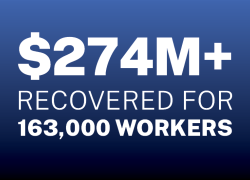
While the gap in pay between men and women has grown smaller over the years, there is still plenty of work to do to close the pay gap, and recent data illuminates how the Wage and Hour Division’s (WHD) can help contribute to closing it.
Every fiscal year, WHD publishes its annual enforcement data summarizing the investigations and results from the last year. One of these tables examines our enforcement work in low wage, high violation industries. In addition to initiating investigations in response to complaints, we also have the authority to initiate investigations. We conduct these strategic initiatives in industries that predominantly employ low-wage workers, have a greater probability of violations, and where workers are more vulnerable and less likely to file a complaint.
According to the Current Employment Statistics Survey from the Bureau of Labor Statistics, women are overrepresented in many of the low-wage, high violation industries where WHD conducts its strategic initiatives. This illustrates the potential impact that our strategic enforcement work can have: Combatting wage theft in industries with occupational segregation can also move the needle towards reducing the wage gap.
WHD’s strategic initiatives continue to have significant impact on working women. Ninety-three percent of workers in childcare services are women, while 88% of workers in hair, nail and skin care services are women. In the last full fiscal year, there were over 450 investigations in these two industries that led to over $670,000 in returned back wages for 1,500 workers. In the healthcare industry, the results are staggering. Seventy-nine percent of workers in the healthcare industry are women. That number includes millions of female health care workers, including home health aides, nursing assistants and phlebotomists. We conducted nearly 2,500 investigations in the healthcare industry in FY 2023. These investigations uncovered nearly $32 million in back wages, which were distributed to over 24,000 workers.
At the Wage and Hour Division, Equal Pay Day is more than an opportunity for reflection – it's an opportunity for action. Our investigators throughout the country prioritize strategic enforcement in low-paying parts of the labor force, which are often women-dominated industries. By making sure women workers get paid what they are owed, we’re taking concrete steps to address the pay gap.
Bonnie Worstell is a policy advisor for the department’s Wage and Hour Division.

 U.S. Department of Labor Blog
U.S. Department of Labor Blog


